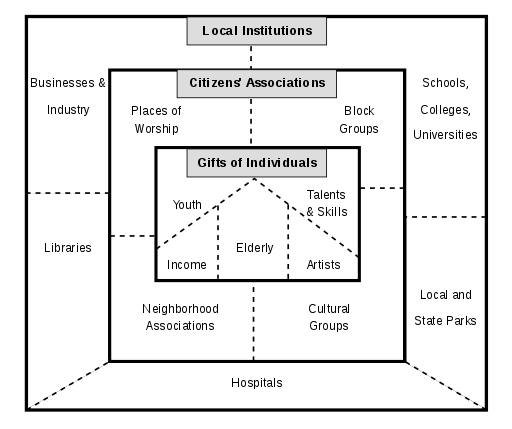Asset-based community development
Asset-based community development (ABCD) is a methodology for the sustainable development of communities based on their strengths and potentials. It involves assessing the resources, skills, and experience available in a community; organizing the community around issues that move its members into action; and then determining and taking appropriate action.[1]
The ABCD approach was developed by John L. McKnight and John P. Kretzmann at the Institute for Policy Research at Northwestern University in Evanston, Illinois. They co-authored a book in 1993, Building Communities from the Inside Out: A Path Toward Finding and Mobilizing A Community’s Assets,[2] which outlined their asset-based approach to community development.[3] The Community Development Program at Northwestern University’s Institute for Policy Research established the Asset-Based Community Development Institute based on three decades of research and community work by John P. Kretzmann and John L. McKnight.
Principles
Whereas needs-based community development emphasizes local deficits and looks to outside agencies for resources, asset-based community development focuses on honing and leveraging existing strengths within the community.[4]:1 Related to tenets of empowerment, it postulates that solutions to community problems already exist within a community’s assets. Principles that guide ABCD include:
- Everyone has gifts: Each person in a community has something to contribute.
- Relationships build a community: People must be connected in order for sustainable community development to take place.
- Citizens at the center: Citizens should be viewed as actors—not recipients—in development.
- Leaders involve others: Community development is strongest when it involves a broad base of community action.
- People care: Challenge notions of "apathy" by listening to people's interests.
- Listen: Decisions should come from conversations where people are heard.
- Ask: Asking for ideas is more sustainable than giving solutions.
- Inside-out organization: Local community members are in control.
- Institutions serve the community: Institutional leaders should create opportunities for community-member involvement, then "step back."[4]:2
Tools
The ABCD approach utilizes several tools to assess and mobilize communities.[2]
Capacity inventory
- Skills Information: lists the many skills that a person has gained at home, work, in the community, or elsewhere. Examples of these skills can include internet knowledge, hair-cutting, listening, wallpapering, carpentry, sewing, babysitting, etc.[5]
- Community Skills: lists the community work in which a person has participated to determine future work they may be interested in.
- Enterprising Interests and Experience: lists past experience in business and determines interest in starting a business.
- Personal Information: lists minimum information for follow-up.
Asset mapping
There are five key assets in any given community: individuals, associations, institutions, physical assets, and connections.[6] These assets are broken down into three categories: Gifts of individuals, Citizens’ Associations, and Local Institutions.[2] Asset maps are used in lieu of needs maps which focus solely on negative aspects of communities. Asset maps, on the other hand, focus on community assets, abilities, skills, and strengths in order to build its future.

Time banks
Time banks are an example of using community assets to connect individuals' assets to one another.[7] Neighbors and local organizations share skills with one another and earn and spend ‘TimeBank Hours’ or ‘credits’ in the process, allowing an hour of child care to equal an hour of home repair or tax preparation.[7]
Ethics
Because ABCD relies on existing community assets to create change, it has been criticized for implying that disadvantaged communities have all the resources they need to solve community problems.[8] According to the ABCD Institute, however, ABCD methodology recognizes that systemic injustice may require disadvantaged communities to seek assistance from outside the community. ABCD maintains that interventions from exterior sources will be most effective when a community’s assets are leveraged at full capacity.[2] ABCD is described as a more sustainable model of community development than needs-based community development, because needs-based approaches may perpetuate community problems by emphasizing deficiencies and the necessity for reliance on outside assistance. By contrast, ABCD aims to build capacity within communities by expanding their social capital.[2]
See also
- Allotment gardens
- Community
- Community advisory board
- Community-based participatory research (CBPR)
- Community development
- Family support
- Neighborhoods
- Participatory rural appraisal (PRA)
- Praxis intervention
- Progress in Community Health Partnerships
- Southeast Asia Rural Social Leadership Institute (SERSOLIN)
References
- ↑ McKnight, John; Kretzmann, John (1996). Mapping Community Capacity (PDF) (Report) (Revised ed.). Evanston, IL: Northwestern University Institute for Policy Research.
- 1 2 3 4 5 Kretzmann, John; McKnight, John (1993). Building Communities From the Inside Out: A Path Toward Finding and Mobilizing a Community's Assets (3rd ed.). Chicago, IL: ACTA Publications. p. 14. ISBN 978-0-87946-108-9. OCLC 36708153.
- ↑ "Asset-Based Community Development Institute". Northwestern University Center for Civic Engagement. Retrieved 22 February 2015.
- 1 2 Rowland, Stan (26 April 2008). "What is Asset Based Community Development (ABCD)" (PDF). Collaborative of Neighborhood Transformation. Retrieved 22 February 2015.
- ↑ McKnight, John; Block, Peter (2010). The Abundant Community: Awakening the Power of Families and Neighborhoods (1st ed.). San Francisco, CA: Berrett-Koehler. ISBN 978-1-60509-584-4. OCLC 876604904.
- ↑ "What is Asset-based community development (ABCD)" (PDF). ABCD Institute. Collaborative for Neighborhood Transformation. Retrieved 22 February 2015.
- 1 2 "What is Timebanking?". TimeBanks. TimeBanks USA. Archived from the original on 2015-02-21. Retrieved 22 February 2015.
- ↑ Ennis, G.; West, Deborah (2010). "Exploring the potential of social network analysis in asset-based community development practice and research". Australian Social Work. 64 (4): 404–417. doi:10.1080/0312407X.2010.508167.
Further reading
- Green, Mike; Moore, Henry; O'Brien, John (2006). When People Care Enough To Act: ABCD in action. Foreword by John McKnight. Toronto: Inclusion Press. ISBN 978-1-895418-74-3. OCLC 70884582.
- Emerson, John (23 June 2004). "What is Asset Mapping?". Social Design Notes. Archived from the original on 2008-10-09.
- Journal: "Progress in Community Health Partnerships: Research, Education, and Action". Johns Hopkins University Press. 2016.
- Journal podcast (episode list): "Beyond the Manuscript". Progress in Community Health Partnerships: Research, Education, and Action. Johns Hopkins University Press. 2016.
External links
- Asset-Based Community Development Institute
- http://www.inspiringcommunities.com Australia/Asia
- http://www.nurturedevelopment.org/ Europe